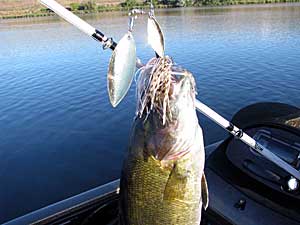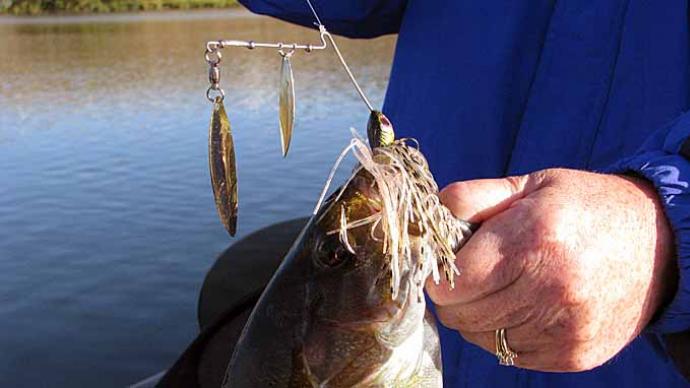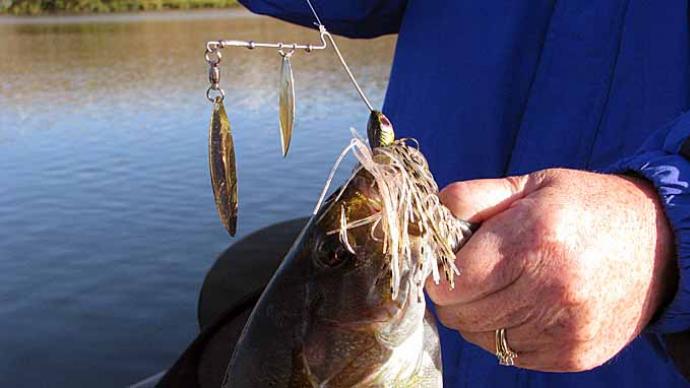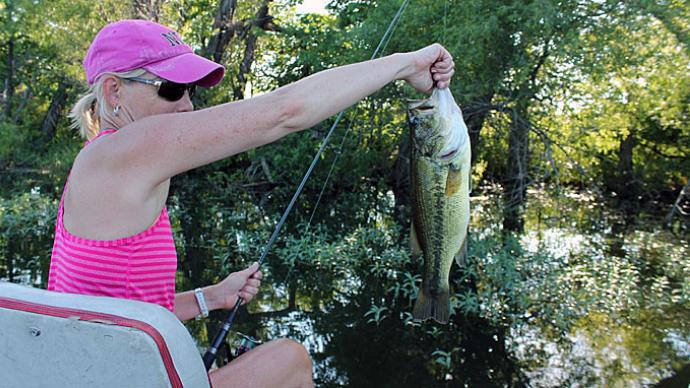
It’s no secret I love to fish a spinnerbait. I’m convinced it’s second only to the worm regarding versatility and productivity.
Not everyone agrees. People tell me they never catch fish on a spinnerbait, even though they’ve tried slow rolling it along drop-offs and crashing it through brush tops. For those with a similar story, perhaps you’re using the wrong spinnerbait design or not fishing it where the bass are. Here are ten tips guaranteed to help make you be more successful.
Keep it simple. Rig a baitcasting outfit with 17-pound test line, tie on a 3/4-ounce spinnerbait, and cast around the thickest cover. The chances of snagging a lure are greater, but so are the chances of catching fish.
Never let the spinnerbait sink out of sight. Jimmy Houston, one of the best spinnerbait fishermen I know, keeps his lure in sight 99 percent of the time. This will help you see strikes and learn to catch bass on a spinnerbait. Also, avoid setting the hook when you see the fish strike. Bass will hold a spinnerbait for a long time, so don’t jerk until the fish is felt.
- Blade selection. Indiana blades offer a good compromise between willow-leaf and Colorado designs. The Colorado creates a lot of vibration, while the willow leaf produces a lot of flash. The Indiana has some of both without overdoing it. There are times, however, when a lure needs more vibration and flash – in dirty water or over thick vegetation. The Colorado will attract stubborn fish to the lure, while the willow-leaf retrieves better through grass.
Tandem vs. single spin. A single spin may produce more vibration, but the tandem helps ensure at least one blade spins continuously when banging brush. If a single-spin blade stops spinning, the lure lays on its side and hangs up. To keep it relatively snag-free, the spinnerbait must be running upright so the wire arm protects the hook. The tandem not only produces more flash but it also can be retrieved more slowly because the two blades provide more lift.
Opt for a single blade when the lure needs to fall. For example, if I want to drop the lure along stumps, docks, or pilings, I prefer a single Colorado blade; it rotates seductively when fished on the fall.
- Lure color. I prefer white in clear water during sunny days, chartreuse and white for dirty water and sunny days, blue and/or chartreuse for clear water on overcast days, chartreuse in dirty water on overcast days, and bright colors in muddy water regardless of sky conditions.
- Vibration. Bigger blades produce more vibration, which is good in some situations. If wind or current has stirred the water, increase the vibration and flash. If it’s calm, try smaller blades with less flash. It’s easy to spook fish in shallow water by throwing big, noisy lures. However, when fishing brush tops in 10 to 15 feet of water, big, flashy baits are best.
Dressings. I always use a 3-inch plastic trailer. Pork rind will work, but it can discolor, whereas plastic trailers remain the same all day. Skirts can make a difference, too. I prefer split-rubber skirts over living-rubber. Always put the skirt on backward; it gives the lure more lift.
I avoid trailer hooks because they prohibit working thick brush – where the fish are. The extra hook simply causes the lure to snag more often.
- Big baits. A 1-ounce spinnerbait is my favorite for slowly winding the lure over the top of deep vegetation, down river ledges, or along large logs in deep water.
- Wire arm. My spinnerbaits are built with 32nd-grade wire, a small wire that creates more vibration. Also, the flexibility of small wire reduces the number of fish lost.
Weather conditions. Low-light days are good spinnerbait days, but the opposite can be true, too. Sunny days push bass under logs and into thick cover, where a spinnerbait will call them out.
Wind can make a difference, too. If you’re catching bass on worms and the wind picks up, switch to a spinnerbait. Chances are you’ll not only catch fish, but bigger ones, too.
- Location. Cover is the key when selecting a location for this lure. In shallow water, swim it through brush or, best of all, along laying logs that angle into deep water. Retrieve the lure slowly through deeper branches, turning the handle just fast enough to keep the line tight. Keep the lure near the structure.
The spinnerbait will catch fish in most waters and under any condition, providing the angler is consistent and selects the right lure for a given area. Gain confidence in it, and you’ll be a firm believer like me.
For more articles, quick tips, and much more, visit HankParker.com.




